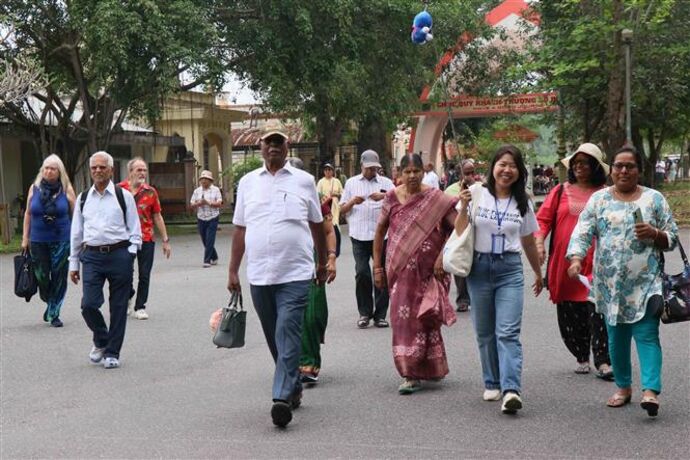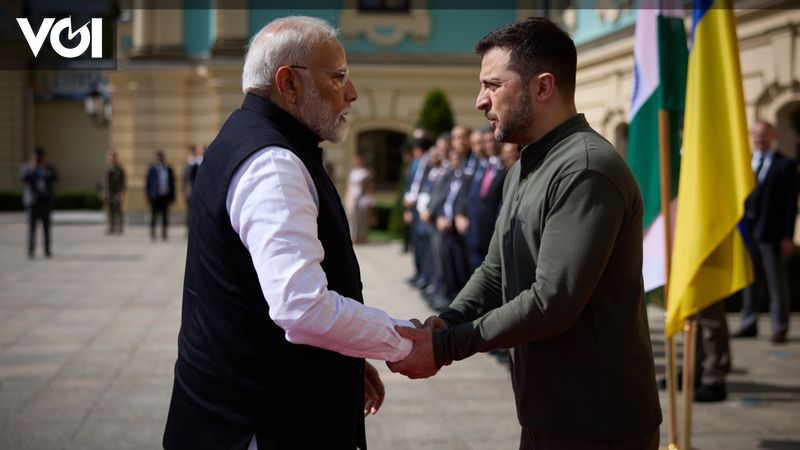Amber (India) – Brigitte Singh places on her desk a square of 17th century Mughal cloth, decorated with large red poppies. This motif, which never ceases to inspire the block print textile designer, who has lived in Rajasthan for forty years, is one of the jewels of his workshop with traditional knowledge.
This French Indian, naturalized in 2002, draws inspiration from the country’s rich heritage, with a tendency to refine ancient Mughal motifs.
“I was the first to offer a revival for this type of Mughal design,” the 67-year-old designer, who was awarded the Legion of Honor in 2015, told AFP.
“Block printing is a very old tradition, impossible until recently, born somewhere between India, China and Tibet,” he continued. Jaipur, where he landed in 1980 at the age of 25, “is the last important stronghold”.
A student in Decorative Arts in Paris, he came with the intention of practicing miniature painting.
“I dreamed of doing it in Isfahan, but the ayatollahs have arrived in Iran, or in Herat, but the Soviets have arrived in Afghanistan”, he said, “I arrived in Jaipur by default”.
– “Magic potion” –
A few months later, he is introduced to a nobleman, also interested in miniatures, related to the Maharaja of Rajasthan. They married in 1982.
In search of traditional paper for his paintings, he came across a block printing workshop. “I fell into a magic potion, with no possibility of returning”.
“I tried the technique of printing a scarf, just to make a gift, inspired by a small 18th century motif”, he says
Two years later, passing through London, he offered some to his friends, enlightened Indian textile amateurs. They encouraged him to show it to Colefax and Fowler, the famous British decorating house.
“And before deciding anything, I returned to India with an order for printed fabric.”
He worked for twenty years with a “printing family” in Jaipur before building, about ten kilometers away, in Amber, his own traditional printing press.
His father-in-law, a great collector of miniatures from Rajasthan, had given him a cloth with “large opium, probably printed for Shah Jahan”, the Mughal emperor to whom India owed the Taj Mahal, he said.
– “Soul comfort” –
“At that time, opium was cultivated in Rajasthan (…) artisans and artists were inspired by what they saw around them,” he said, explaining why opium became such a widespread ornament.
This re-edition of the old pattern, “took for what it is”, has made it a huge hit with textile art connoisseurs around the world and with its Indian, British and Japanese clients.
His latest creation printed with a “big poppy” is a Mughal-inspired quilted cotton coat, called “Atamsukh”, which means “comfort of the soul”, and is intended for a Kuwaiti prince.
A copy dating from 2014 is in the collection of the Victoria & Albert Museum in London. The Metropolitan Museum of Art in New York has shorts by Brigitte Singh.
“I took all the liberties in the world with patterns and colors”, he admits in his drawing studio, “I’m not a historian!”
He worked with a brush to give his sculptor Rajesh Kumar a very precise image who carved it on the wooden board used for printing.
– “The sophistication of simplicity” –
He reproduces the patterns, from demanding finesse, identically, to each color.
“The poppy flower pattern, for example, has five colors, so I had to carve five boards,” he explained in the workshop, “it took me twenty days.”
“We needed an excellent sculptor, with a very serious eye”, the designer emphasized, “the sculpted board is the key! This tool has the sophistication of simplicity”.
In the printing job, six workers worked on a long table, covered with 24 layers of cloth so as not to damage the boards they used to stamp the cotton canvases.
Firm but smooth, they print no more than 40 meters of fabric per day.
“Each color has to be layered, one at a time, with precision,” says Matin Anwar Khan, head of the workshop and colorist, “it takes several days of trial and error to compose an accurate and uniform color”.
Once the “gravy” has been approved, the movement of the printers is involved, from table to table, in their invariable choreography.
“They have smart hands,” said Brigitte Singh. “The important thing is to keep this knowledge alive. More valuable than a product, knowledge is a great treasure.”

“Twitter junkie. Hipster-friendly bacon expert. Beer ninja. Reader. Communicator. Explorer. Passionate alcohol geek.”







